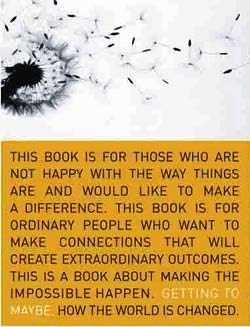On June 4, 2008 I wrote about Using Evidence by Nutley, Walter and Davies. This book has been my principal KM reference but I have a new, equally favourite, book to recommend to you: Getting to Maybe by Frances Westley, Brenda Zimmerman (of York’s Schulich School of Business, ) and Michael Quinn Patton. Using Evidence is about the science of research utilization (=knowledge mobilization) for policy and practice (=social innovation). Getting to Maybe is about the actors (=social innovators) who operate within a system of social innovation. Using case studies of successful social innovators, Getting to Maybe illustrates how social innovators can maximize the chances of creating an impact and it provides numerous recommendations for social innovators, their organizations (usually NGOs), their funders (usually Foundations) and their receptors (usually policy makers). Getting to Maybe doesn’t guarantee success or present a formula which, if followed, will generate results. Getting to Maybe focuses on key learnings that are important for all social innovators and their stakeholders.
Finally Getting to Maybe about creating the right conditions where maybe, change might happen.
 This book contains valuable lessons and will inform much of the work of knowledge brokers. Order your copy here.
This book contains valuable lessons and will inform much of the work of knowledge brokers. Order your copy here.
Some KM relevant messages from Getting to Maybe:
• Social innovation is a complex (as opposed to complicated) problem. Complexity science can guide approaches to social innovation.
• Relationships, amongst other attributes, are key for social innovation
• Individuals operate in systems and successful social innovators examine their own role in those systems
• Premature evaluation can stifle social innovation by seeking end points; developmental evaluation focuses on learnings not end points
• All systems must go through cycles of exploitation → conservation → release (=“creative destruction”) → reorganization in order to remain innovative and avoid the “rigidity gap”. This is why “success is not a fixed address”.
• Social innovation is catalyzed through connection, confrontation and collaboration.
• It is important to stand still, to reflect and analyze. Reflection is action. This is a particularly important message for me, personally, as I tend to race more than I reflect.
• Social Innovation is like improvising jazz: every player listens, understands and everyone leads from their own place of understanding.